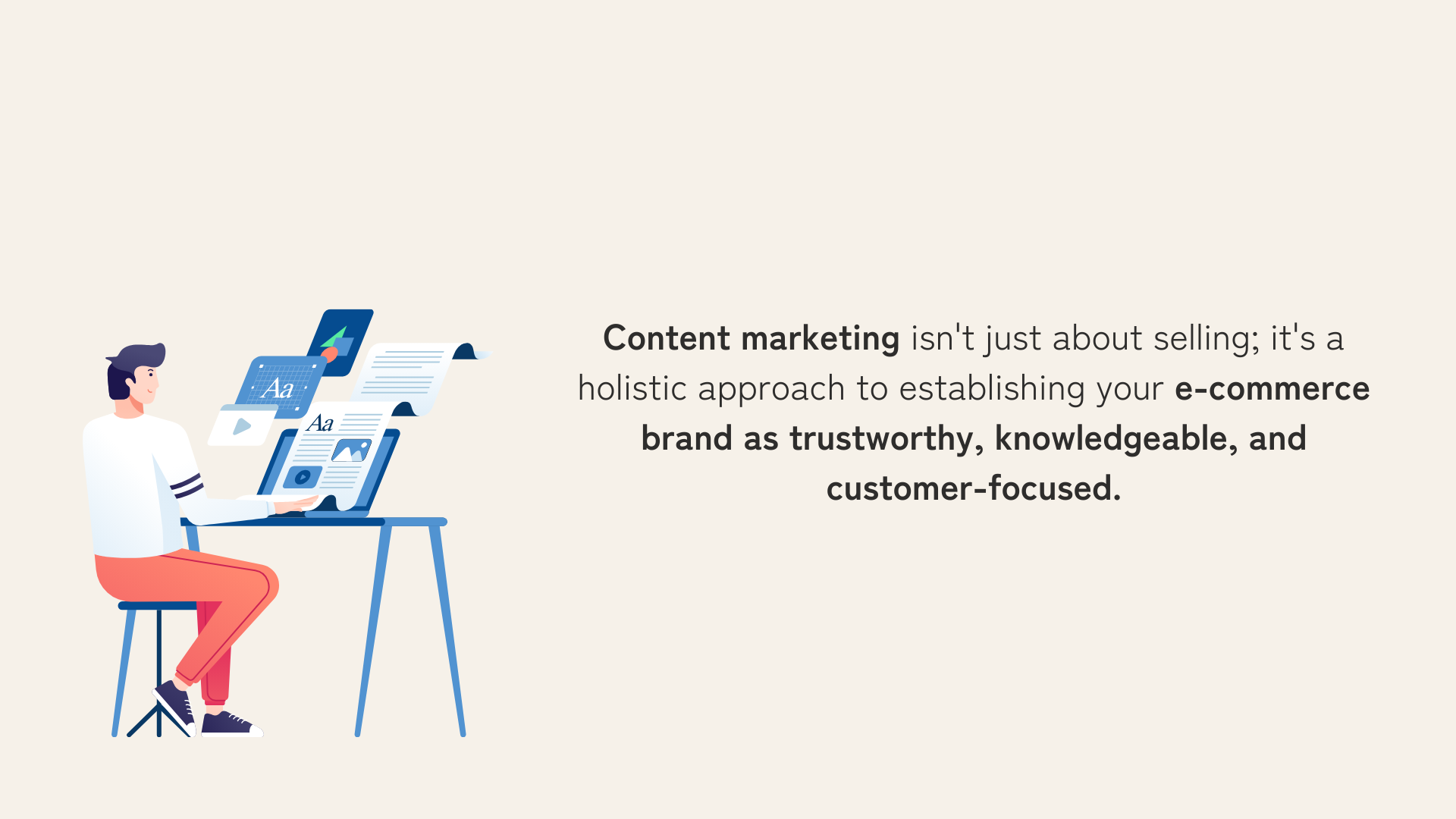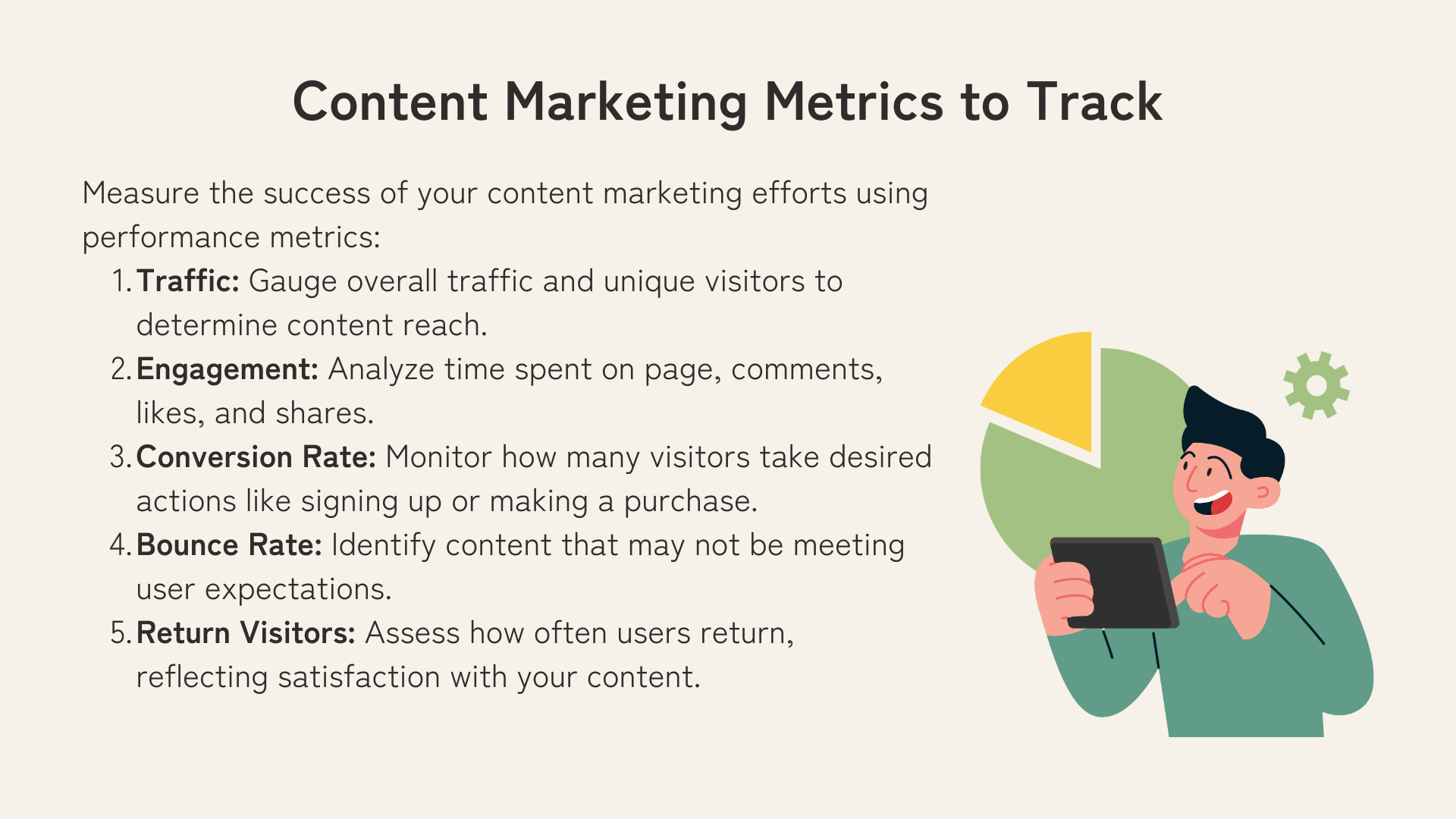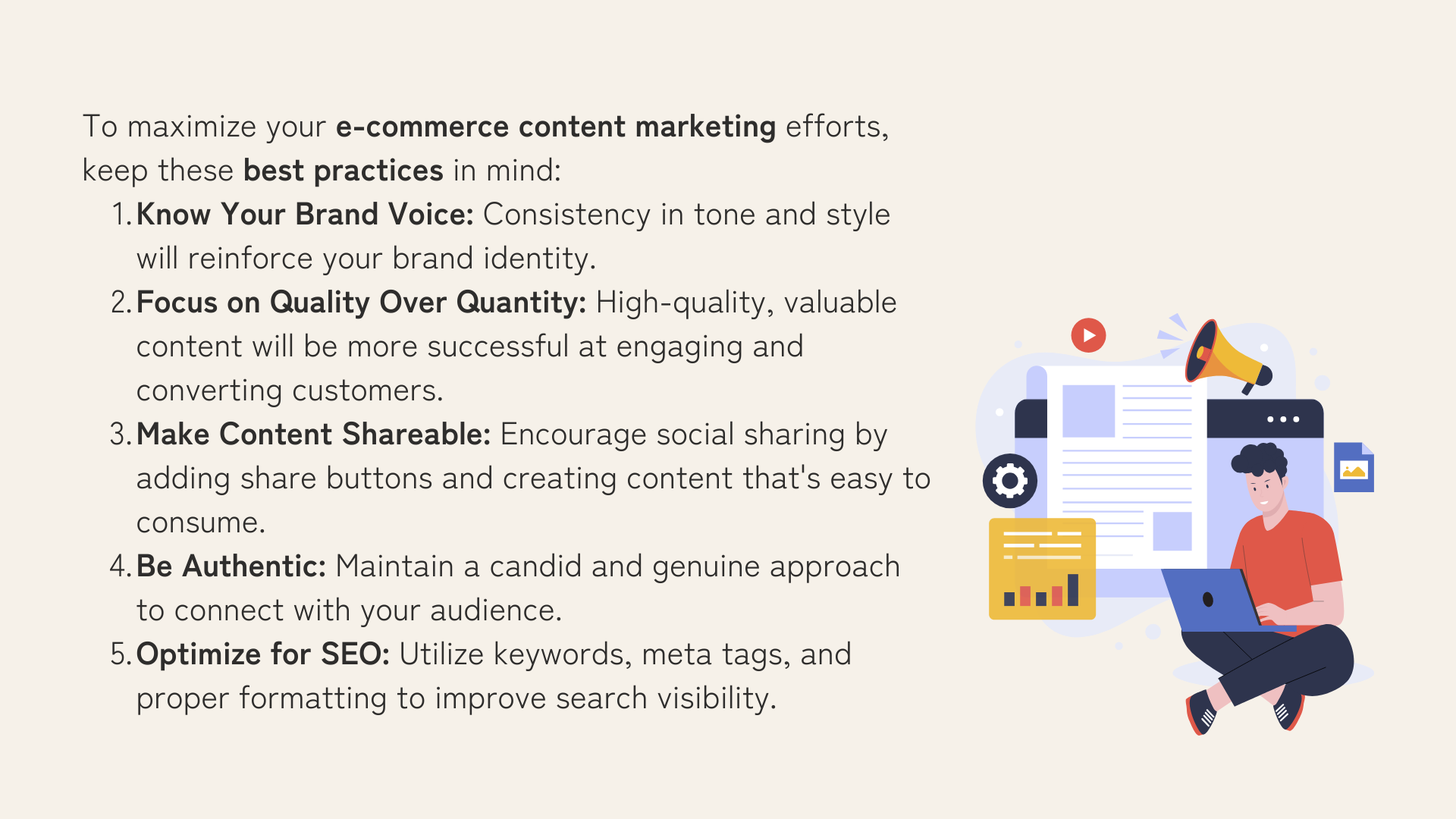Introduction
In the ever-evolving digital marketplace, e-commerce businesses are in a constant battle to capture attention, build meaningful connections, and boost sales.
At the heart of winning this battle is content marketing—a strategic approach that can immensely benefit e-commerce brands when executed correctly.
Content marketing has become a critical component of modern e-commerce strategies, helping businesses attract, engage, and convert customers via compelling content.
In this comprehensive guide, we'll delve into the world of e-commerce content marketing, offering key insights and actionable advice for beginners.
What is E-Commerce Content Marketing?
E-commerce content marketing refers to the creation and sharing of relevant, valuable, and engaging content to attract, inform, and ultimately persuade your online target audience to make a purchase or take a specific action on your e-commerce platform.
It encompasses a range of formats, including blog articles, videos, podcasts, social media posts, email campaigns, and more.
In essence, content marketing helps you build trust, brand awareness, and customer loyalty, fueling the growth of your e-commerce business.
Why Content Marketing is Essential for E-Commerce
Content marketing transcends conventional marketing techniques by offering value beyond product descriptions and sales pitches.
It's an avenue for storytelling, providing useful information, and establishing relationships with customers.
In the context of e-commerce, content marketing can be a game-changer, setting your brand apart in a crowded online space.
The benefits of content marketing for e-commerce are manifold:
1. Builds Trust with Your Audience
When customers find high-quality content that addresses their questions and needs, they begin to trust the source.
For e-commerce, this means if you provide informative articles, how-to guides, or product reviews, you build credibility.
Trust is crucial in the digital realm where consumers can't physically touch products before purchasing. Good content bridges that gap.
2. Improves Brand Awareness
Every time you publish content online, there's an opportunity for new customers to find out about your store.
Consistent, helpful content can position your brand in customers' minds, so when they're ready to buy, they think of you first.
Remember, it's not about a single touchpoint; it's about creating a consistent presence across various channels and content formats.
3. Supports Your SEO Efforts
Search engines reward websites that publish quality, consistent content. E-commerce businesses that take SEO seriously benefit from a boost in organic traffic.
Diverse content with targeted keywords can rank your store's pages higher on search engine results pages (SERPs), meaning more potential customers find your products.
4. Enhances Customer Engagement
Customer engagement is about connecting with your audience in a meaningful way.
Engaging content – whether informative blog posts, fun videos, or interactive social media content – encourages visitors to spend more time on your site and interact with your brand.
Increased engagement can improve customer loyalty and encourage repeat purchases.
5. Generates Leads
Content marketing can generate leads by attracting potential buyers to your website.
According to Content Marketing Institute, content marketing gets three times more leads than paid search advertising.
Once they're on your site, you can employ tactics like lead magnets—free downloadable content in exchange for contact information—or encouraging newsletter sign-ups to nurture these leads down your sales funnel.
6. Converts leads into Customers
Content can do more than attract visitors; it can convince them to buy. Detailed product information, convincing case studies, and enticing product videos can turn an uncertain visitor into a confident customer.
Your content should answer any questions they might have and validate their decision to purchase from you.
7. Allows You to Educate Your Customers
Educating customers about your products can help reduce returns and increase satisfaction.
Content that explains how to use your products, how to choose the right model, or how to maintain them adds value to the customer experience.
An informed customer is more likely to be a happy customer.
8. Sets You Apart from Competitors
No matter what you sell, competition is fierce in the e-commerce space. Original content can differentiate your brand by showcasing your unique voice, expertise, and value proposition.
By educating and engaging customers, you give them reasons to choose you over competitors.
9. Provides Insights into Your Audience
Content marketing tools can offer analytics that gives you a better understanding of your audience's preferences and behaviors.
By examining which pieces of content are most popular, you can hone in on what your customers want and refine your product offerings and marketing strategies accordingly.
10. Facilitates Customer Retention and Loyalty
Creating consistent, quality content keeps your customers returning to your website for information, entertainment, and solutions.
Over time, this builds customer loyalty, as they begin to rely on your brand as an authoritative source.
Loyal customers are more likely to make repeat purchases and advocate for your brand.
11. Creates Opportunities for Shared Content
When you create compelling content, people want to share it. Whether it’s a thoughtful blog post or an instructive video, shareable content can significantly increase your brand’s reach.
It also acts as a personal endorsement of your brand, as people tend to share content that they find useful or aligns with their values.

Crafting Your E-Commerce Content Marketing Strategy
To establish a solid content marketing strategy, follow these key steps:
1. Define Your Goals
Start by outlining your content marketing goals. They should align with your overall e-commerce strategy.
Possible goals include driving website traffic, increasing sales, building brand awareness, or fostering customer loyalty.
2. Identify Your Target Audience
Understanding your target audience informs the type of content you create. Determine your audience's demographics, including age, gender, location, and interests.
Create buyer personas to represent your ideal customers and guide content creation.
3. Conduct Content Research
Examine your industry, competitor content, and customer needs to determine what type of content would offer the most value. Identify popular topics, trends, and gaps in existing content.
4. Choose Content Types and Channels
Select the types of content and channels that will resonate most with your audience. These include:
- Blog articles: Offer in-depth information, tips, and insights on topics relevant to your audience.
- Videos: Showcase your products, offer demonstrations, or share customer stories.
- Podcasts: Share industry insights, interviews, or advice in an audio format.
- Social media posts: Engage with your audience, share updates, or promote new content.
- Email campaigns: Send newsletters, promotional offers, or share personalized content with subscribers.
5. Establish an Editorial Calendar
An editorial calendar streamlines content creation and helps you track progress. Plan content type, topic, publication date, and author; adjust as needed.
6. Produce and Publish High-Quality Content
With your strategy in place, it's time to produce and publish content. Prioritize creating valuable, engaging, and error-free content.
Stay consistent with your brand voice and maintain content diversity.
7. Monitor and Optimize Performance
Track your content's performance using analytics. Measure metrics like page views, clicks, shares, and conversion rates.
Use this data to optimize your content strategy, making adjustments as necessary.

Content Promotion and Distribution
Creating stellar content is only half the battle in the digital marketplace.
Without proper promotion and distribution, even the most well-crafted blog posts, videos, and infographics might languish unseen.
Understanding how to effectively disseminate content can amplify your e-commerce business's reach, attract more customers, and ultimately impact your bottom line.
Why Promote and Distribute E-Commerce Content?
1. Increased Visibility
Your content might be valuable, but if no one sees it, it can't contribute to your e-commerce goals.
Promotion ensures that your target audience encounters your content at the right place and time.
2. Driven Traffic
Strategic promotion and distribution can lead to an influx of visitors to your website, which can translate into higher sales.
3. Improved Engagement
Engaging with your content encourages customers to spend more time interacting with your brand, which can foster loyalty and community.
Strategies for Promoting E-Commerce Content
Social Media Sharing
Social media platforms like Facebook, Instagram, Twitter, and Pinterest can be powerful drivers of traffic.
Sharing your content here can also stimulate engagement and shares, multiplying its reach.
For example, a shareable infographic detailing "10 Must-Have Summer Accessories" on Instagram could quickly gain traction in the right communities.
Email Marketing
Directly engage with customers by incorporating content into newsletters and promotional emails.
Statistics show that email marketing yields an average return of $42 for every $1 spent, testament to its effectiveness.
Highlighting a blog post on "The Beginner's Guide to Home Baking" in a newsletter could drive budding bakers to your e-commerce kitchen supply store.
Influencer Collaboration
Partnering with influencers to share or create content can expose your brand to wider audiences.
An example could be a fashion blogger showcasing your latest apparel in a lookbook on their blog or social media.
Paid Advertising
Pay-per-click (PPC) campaigns, social media ads, and display adverts can target specific audiences with your content.
This might include promoting a video tutorial on how to use your product via YouTube advertising.
Search Engine Optimization (SEO)
SEO should underpin your content creation, ensuring that your articles and pages rank well in search engine results.
Implement search engine optimization techniques to improve your content's visibility in search results.
Quality content with the right keywords attracts organic traffic, which is both cost-effective and beneficial for long-term visibility.

Sanka for Your E-Commerce Marketing
Introducing Sanka - your all-in-one e-commerce content marketing solution designed specifically to grow your online store.
With over a decade of experience in e-commerce consulting, Sanka offers you the most comprehensive set of tools to streamline your e-commerce operations, from product research to customer services and order management.
Why choose Sanka? It's customizable to fit your unique needs and integrates seamlessly with your existing workflow.
Our popular solutions not only improve ROAS, but also automate time-consuming tasks to maximize efficiency.
Trusted by industry leaders, with over 1,000 clients and 100 active users, Sanka is the first choice for those looking to optimize their e-commerce business.
Act now and unlock your e-commerce potential with Sanka! Enjoy a free trial and experience the benefits of consolidated ecommerce management tools that will help you achieve over 1,000% ROI.
Conclusion
E-commerce content marketing can be a powerful tool for attracting, engaging, and converting customers while building trust and brand loyalty.
By crafting a robust content strategy and following best practices, even beginners in the e-commerce space can leverage content marketing to benefit their business.
The journey might be filled with challenges, but with the right approach, determination, and persistence, your e-commerce content marketing efforts can drive meaningful results and contribute to your business's growth.








